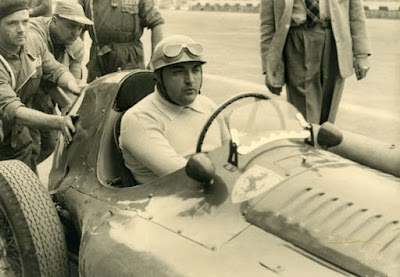The business of supplying the world's fastest and most elite racecars with rubber may be glamorous, but it isn't always profitable. While the technological transfer can be useful to a tire maker, the cost can be punishing. But for Pirelli, whose competition successes go back more than a hundred years—beginning with Prince Scipione Borghese's victory in a seven-litre Itala in the grueling Peking-to-Paris road race of 1907—it is often the price of doing business.
Venturing in and out of racing's most elite forums, since it won its first international Grand Prix in 1913, the company left the circuit in the 1950s, following a run of victories in the early 1950s with Alberto Ascari and Ferrari. Returning to the Formula One fold twice in the 1980s (with drivers like Ayrton Senna, Nelson Piquet, and Gerhard Berger deploying its wares), it bowed out following the 1991 season, only to return to race again in 2010, supplying all of the major teams.
While today's Pirelli tires are easily the most technically advanced and most capable ever, a recent perusal of the company's archives in Milan—Archivio Storica Pirelli—uncovered a treasure trove of images depicting the venerable firm's faraway racing history. Wildly colorful, though they are shot in black and white, these pictures take us back to a time when grizzled daredevils in leather helmets risked their lives, pushing the boundaries of automotive performance.
Above: Driver Felice Nazzaro in 1922 at Automobil Club Grand Prix in France, which he won in his Fiat 804.
A Who's Who of early Italian Grand Prix dignitaries, circa 1924: Giulio Ramponi, (mechanic, engineer, and racer), Giuseppe Campari (famous Alfa pilot), Nicola Romeo (leading engineer and the Romeo in Alfa Romeo), and Antonio Ascari (accomplished racer, father of future champion Alberto Ascari, he'd die in a racing accident), at the Italian Grand Prix in Monza.
The Italian Grand Prix at Monza, 1932; then, as now, a racetrack is always a good place, and race day always a good time for self-promotion.
Start of the Monza Grand Prix, 1948.
Start of the Monza Grand Prix, 1948.
Legendary piloti Alberto Ascari after winning the 1950 Grand Prix in Monza, Italy, on Pirelli's "Stella Bianca" tires. Pirelli won its first international grand prix in 1913, with Georges Boillot behind the wheel of a Peugeot at the Amiens circuit in France.
A Pirelli race tender at the 1952 Monza, won by Alberto Ascari in a Ferrari.
A pair of Pirelli-shod Ferraris, driven by Alberto Ascari and Nino Farina, cornering hard at 1952's Monza race.
José Gonzåles's factory-prepared Maserati A6GCM running in the 1952 Italian Grand Prix, where he'd jointly set the fastest lap.
Juan Manuel Fangio in his Maserati A6GCM with his Argentine countryman, José Gonzales, similarly equipped and in hot pursuit, at the Buenos Aires Grand Prix in 1953. Fangio would retire, while Gonzales would finish third.
Fangio in his Maserati and Nino Farina in a Ferrari 500, snaring first and second place at Monza in 1953. Pirelli's first Grand Prix World Championship had come in 1925 when Gastone Brilli Peri won at Monza in an Alfa Romeo.
Gonzales with his Ferrari 553 Squalo at the Siracusa circuit in Sicily, 1954, before a fire ended his race prematurely.
Juan Manuel Fangio, José Gonzales, Umberto Maglioli, and Nino Farina, 1954.
A Pirelli-shod Ferrari 375 driven by Maurice Trintignant visits the pit lane on it way to winning 1954 24 Hours of Le Mans.
The starting grid for the 1954 British Grand Prix, held at England's Silverstone circuit.
Highly regarded Lancia D50s raced by Alberto Ascari and Luigi Villoresi at Monte Carlo, for the 1955 European Grand Prix. Ascari would soon be dead, killed while practicing in a friend's Ferrari at Monza.
Juan Manuel Fangio and Stirling Moss pound their Mercedes along the banking at Monza during the 1955 Grand Prix, which Fangio would win, shortly before Mercedes's withdrawal from racing following a disastrous accident at LeMans.
Luigi Piotti in a Maserati, 1956. A middle-aged privateer of some means, Piotti's most successful moment may have come when he pushed Stirling Moss's Maserati to the pits after it ran out of gas during the Italian Grand Prix. Moss went on to win the race and protests based on Moss's "outside assistance" failed, when Piotti was adjudicated an informal member of Maserati's team.
Tazio Nuvolari, in 1933, with his Pirelli-shod Alfa Romeo 8C 2600 at Alessandria's Pietro Bordino track, named after a leading Fiat driver who died here when he hit a dog, flipped his car and drowned in an adjacent river. The 8C, a straight-eight engine of advanced design, was one of the many great works of engineering legend Vittori Jano.
Ascari getting acquainted with his revolutionary new D50 Lancia, 1954. The company's first-ever Grand Prix car, it was a radical design. Compact and with a low center of gravity, it featured a load-bearing V8 engine and early ground effects, but after lead Lancia driver Ascari's death, the flame went out and the program was sold to Ferrari.
Fangio, the master, readies for the start of the 1949 Argentine Grand Prix, in the country of his birth. His record of five F1 World Driver's Championships would stand until Michael Schumacher won his sixth 46 years later.
How differently racers dressed: Fangio, trackside in 1953. It was not unusual, back in the day, to race in short sleeves. Needless to say, many died in crashes that today they'd walk away from.
The Parabolica, Monza Grand Prix, 1955. In later years, the course would be reconfigured to discourage the high speeds that were routinely being achieved, for safety reasons.
By Jamie Lincoln Kitman
Read More http://www.gq.com/cars-gear/cars/201205/pirelli-formula-one-racing-history-photos#ixzz25tNl0kvw






















